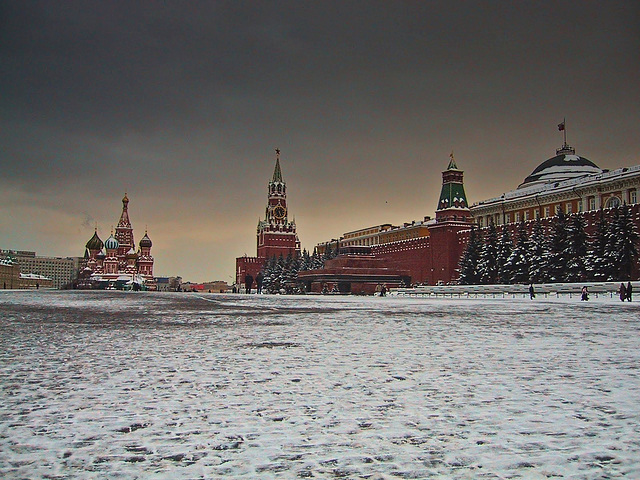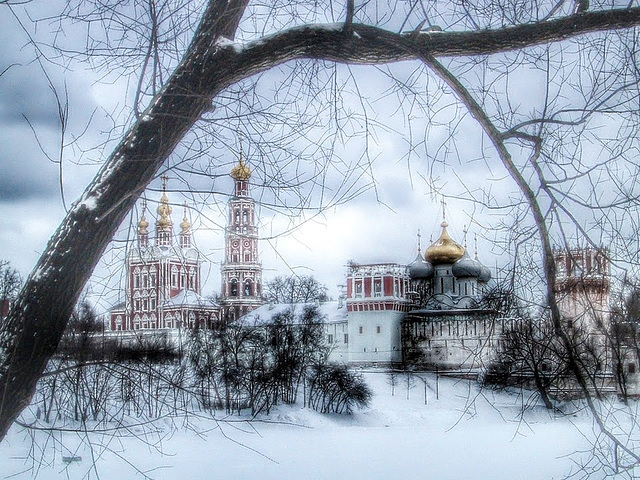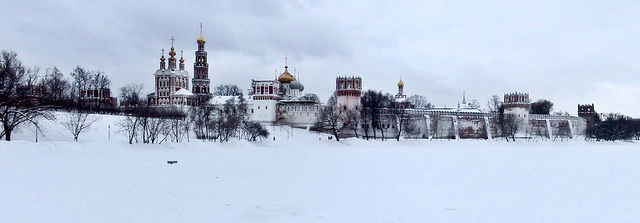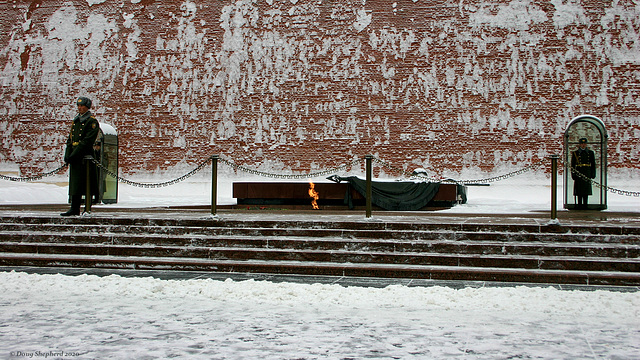
Moscow
The Kremlin over the Moskva River Panorama
The Moscow Kremlin (Russian: Моско́вский Кремль, tr. Moskovskiy Kreml; IPA: [mɐˈskofskʲɪj krʲɛmlʲ]), usually referred to as the Kremlin, is a fortified complex at the heart of Moscow, overlooking the Moskva River to the south, Saint Basil's Cathedral and Red Square to the east, and the Alexander Garden to the west. It is the best known of the kremlins (Russian citadels) and includes five palaces, four cathedrals, and the enclosing Kremlin Wall with Kremlin towers. The complex serves as the official residence of the President of the Russian Federation.
The name Kremlin means "fortress inside a city",and is often also used as a metonym to refer to the government of the Russian Federation in a similar sense to how the White House is used to refer to the Executive Office of the President of the United States. It had previously been used to refer to the government of the Soviet Union (1922–1991) and its highest members (such as general secretaries, premiers, presidents, ministers, and commissars).
Red Square, Moscow
Red Square (Russian: Кра́сная пло́щадь, tr. Krásnaya plóshchaď; IPA: [ˈkrasnəjə ˈploɕːətʲ]) is a city square (plaza) in Moscow, Russia. It separates the Kremlin, the former royal citadel and currently the official residence of the President of Russia, from a historic merchant quarter known as Kitai-gorod. Red Square is often considered the central square of Moscow since Moscow's major streets, which connect to Russia's major highways, originate from the square.
The name Red Square neither originates from the pigment of the surrounding bricks (which, in fact, were whitewashed at certain periods) nor from the link between the colour red and communism. Rather, the name came about because the Russian word красная (krasnaya), which means both "red" and "beautiful," was applied to a small area between St. Basil's Cathedral, the Spassky Tower of the Kremlin, and the Lobnoe Mesto (it actually never was a place of execution), and Tsar Alexei Mikhailovich officially extended the name to the entire square, which had previously been called Pozhar, or "burnt-out place", in reference to the fact that several buildings had to be burned down to make place for the square. Several ancient Russian towns, such as Suzdal, Yelets, and Pereslavl-Zalessky, have their main square named Krasnaya ploshchad.
Novodevichy (New Maiden) Convent, Moscow
The Novodevichy Convent, situated in the south-western part of the historic town of Moscow at the crossing of the Moscow River, was founded by Grand Duke Vasily III in the 1520s and was a part of a chain of monastic ensembles that were integrated into the defence system of the city. It is an outstanding example of Orthodox architecture. The ensemble consists of 14 buildings, including 8 cathedrals (a shrine, 4 churches, a belfry with the Barlaam and Josaphat church and two chapels) and a number of residential and service buildings. The monastery is sometimes called “the Moscow Kremlin in miniature”. Its oldest building is a stone cathedral dedicated to the Icon of the Mother God of Smolensk built in 1524–1525 after the fashion of the Assumption Cathedral in the Moscow Kremlin.
The Convent is the only ancient nunnery which served as a fortress at the same time. In the 16th-18th centuries the nunnery was the chosen convent for women from the tsarist dynasty as well as the wealthy boyar and nobility families to take the veil. The Novodevichy Convent had close links to the Kremlin and is closely linked to the political, cultural and religious history of Russia, to major historic events and to important historic figures of the Russian state. These include Ivan the Terrible, Boris Godunov and the Time of Trouble of early 17th century, the father of Peter the Great, Alexey Michailovich as well as his daughter Princess Sofia Alekseevna and her struggle for power with the incoming Emperor Peter I, and the Patriotic War against Napoleon in 1812.
The elite nature of the convent means that it contains examples of the highest class of architecture with rich interiors. Built in the late 17th century, the monastery is one of the most outstanding and representative examples of the so-called “Moscow Baroque”, having retained its integrity better than any of the other rebuilt monasteries in Moscow.
Novodevichy (New Maiden) Convent, Panorama
The Novodevichy Convent, situated in the south-western part of the historic town of Moscow at the crossing of the Moscow River, was founded by Grand Duke Vasily III in the 1520s and was a part of a chain of monastic ensembles that were integrated into the defence system of the city. It is an outstanding example of Orthodox architecture. The ensemble consists of 14 buildings, including 8 cathedrals (a shrine, 4 churches, a belfry with the Barlaam and Josaphat church and two chapels) and a number of residential and service buildings. The monastery is sometimes called “the Moscow Kremlin in miniature”. Its oldest building is a stone cathedral dedicated to the Icon of the Mother God of Smolensk built in 1524–1525 after the fashion of the Assumption Cathedral in the Moscow Kremlin.
The Convent is the only ancient nunnery which served as a fortress at the same time. In the 16th-18th centuries the nunnery was the chosen convent for women from the tsarist dynasty as well as the wealthy boyar and nobility families to take the veil. The Novodevichy Convent had close links to the Kremlin and is closely linked to the political, cultural and religious history of Russia, to major historic events and to important historic figures of the Russian state. These include Ivan the Terrible, Boris Godunov and the Time of Trouble of early 17th century, the father of Peter the Great, Alexey Michailovich as well as his daughter Princess Sofia Alekseevna and her struggle for power with the incoming Emperor Peter I, and the Patriotic War against Napoleon in 1812.
The elite nature of the convent means that it contains examples of the highest class of architecture with rich interiors. Built in the late 17th century, the monastery is one of the most outstanding and representative examples of the so-called “Moscow Baroque”, having retained its integrity better than any of the other rebuilt monasteries in Moscow.
Waiting for a trolleybus, Leninskiy Prospekt, Moscow
Leninsky Avenue (Russian: Ле́нинский проспе́кт) is a major avenue in Moscow, Russia, that runs in the south-western direction between Kaluzhskaya Square in the central part of the city through Gagarin Square to the Moscow Ring Road.
The location of the current avenue has been a road since before the 18th century. Only the area between Kaluzhskaya Square and Kaluzhskaya Zastava Square (currently Gagarin Square) was then included into Moscow, and the name of this stretch was Bolshaya Kaluzhskaya Street. Construction was active in that area between the 18th century and the 1940s.
It is the second widest street in Moscow after Leningradsky Avenue. Its width varies between 108 and 120 metres.
The Eternal Flame of Glory at the Tomb of the Unknown Soldier - Kremlin Wall, Moscow
The Tomb of the Unknown Soldier is a war memorial, dedicated to the Soviet soldiers killed during The Great Patriotic War. The term Great Patriotic War (22 Jun 1941 – 9 May 1945) appeared in the Soviet newspaper Pravda on 23 June 1941, just a day after Nazi Germany invaded the Soviet Union. It was found in the title of "The Great Patriotic War of the Soviet People". It is a tradition for newly married couples in Moscow to lay flowers at the Tomb of the Unknown Soldier.
The Tomb is located at the Kremlin Wall in the Alexander Garden in Moscow. The remains of the unknown soldiers killed in the Battle of Moscow in 1941 were initially buried in a mass grave of the Shtyki Memorial at the 40th km of the Leningrad highway at the city of Zelenograd. This was the location of the closest approach of the German armies to Moscow during the war. To commemorate the 25th anniversary of the battle, in December 1966 these remains were relocated to the Kremlin Wall.The Tomb of the Unknown Soldier was designed by architects D. I. Burdin, V. A. Klimov, Yu. R. Rabayev and sculptor Nikolai Tomsky, and was unveiled to the public on May 8, 1967.
The dark red porphyry monument is decorated with a bronze sculpture of a laurel branch and a soldier's helmet laid upon a banner. In front of the monument, there is a five-pointed star in a square field of labradorite, which emanates the Eternal Flame from its center. The flame illuminates a bronze inscription "Имя твоё неизвестно, подвиг твой бессмертен" , "Your name is unknown, your deed is immortal"). The torch for the memorial's Eternal Flame was transported from Leningrad, where it had been lit from the Eternal Flame at the Monument to the Fighters of the Revolution on the Field of Mars. To the left of the tomb is a granite wall with an inlay stating: "1941 - To Those Who Have Fallen For The Motherland - 1945".
To the right of the tomb, lining the walkway are dark red porphyry blocks with incapsulated soils from hero cities, Leningrad, Kiev, Stalingrad, Odessa, Sevastopol, Minsk, Kerch, Novorossiysk, Tula and Brest, Murmansk and Smolensk. The plate for “Stalingrad” read “Volgograd” until September 2004. Further to the right of these monuments is an obelisk in red granite, listing the names of 40 “Cities of Military Glory” divided into groups of four. This monument was dedicated on May 8, 2010.
In memory of Guy Somerfield of York
Tomb of the Unknown Soldier - "Your name is unknown, your deed is immortal" - Kremlin Wall, Moscow (1 x PiP)
The Tomb of the Unknown Soldier is a war memorial, dedicated to the Soviet soldiers killed during The Great Patriotic War. (22 Jun 1941 – 9 May 1945) The term Great Patriotic War appeared in the Soviet newspaper Pravda on 23 June 1941, just a day after Nazi Germany invaded the Soviet Union. It was found in the title of "The Great Patriotic War of the Soviet People". It is a tradition for newly married couples in Moscow to lay flowers at the Tomb of the Unknown Soldier.
The Tomb is located at the Kremlin Wall in the Alexander Garden in Moscow. The remains of the unknown soldiers killed in the Battle of Moscow in 1941 were initially buried in a mass grave of the Shtyki Memorial at the 40th km of the Leningrad highway at the city of Zelenograd. This was the location of the closest approach of the German armies to Moscow during the war. To commemorate the 25th anniversary of the battle, in December 1966 these remains were relocated to the Kremlin Wall.The Tomb of the Unknown Soldier was designed by architects D. I. Burdin, V. A. Klimov, Yu. R. Rabayev and sculptor Nikolai Tomsky, and was unveiled to the public on May 8, 1967.
The dark red porphyry monument is decorated with a bronze sculpture of a laurel branch and a soldier's helmet laid upon a banner. In front of the monument, there is a five-pointed star in a square field of labradorite, which emanates the Eternal Flame from its center. The flame illuminates a bronze inscription "Имя твоё неизвестно, подвиг твой бессмертен" , "Your name is unknown, your deed is immortal"). The torch for the memorial's Eternal Flame was transported from Leningrad, where it had been lit from the Eternal Flame at the Monument to the Fighters of the Revolution on the Field of Mars. To the left of the tomb is a granite wall with an inlay stating: "1941 - To Those Who Have Fallen For The Motherland - 1945".
To the right of the tomb, lining the walkway are dark red porphyry blocks with incapsulated soils from hero cities, Leningrad, Kiev, Stalingrad, Odessa, Sevastopol, Minsk, Kerch, Novorossiysk, Tula and Brest, Murmansk and Smolensk. The plate for “Stalingrad” read “Volgograd” until September 2004. Further to the right of these monuments is an obelisk in red granite, listing the names of 40 “Cities of Military Glory” divided into groups of four. This monument was dedicated on May 8, 2010.
In memory of Guy Somerfield of York
Jump to top
RSS feed- Latest items - Subscribe to the latest items added to this album
- ipernity © 2007-2024
- Help & Contact
|
Club news
|
About ipernity
|
History |
ipernity Club & Prices |
Guide of good conduct
Donate | Group guidelines | Privacy policy | Terms of use | Statutes | In memoria -
Facebook
Twitter








